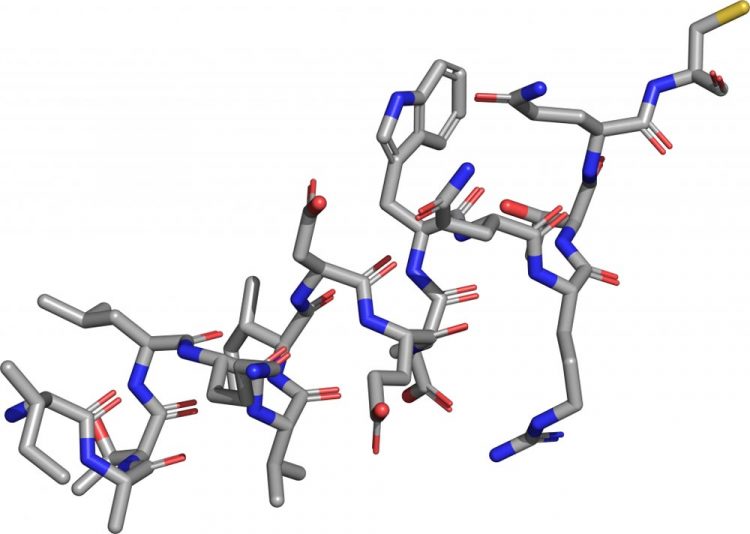Protecting the Neuronal Architecture

Three-dimensional chemical structure of the VEGFD-based therapeutic. © Hilmar Bading
Protecting nerve cells from losing their characteristic extensions, the dendrites, can reduce brain damage after a stroke. Neurobiologists from Heidelberg University have demonstrated this by means of research on a mouse model.
The team, led by Prof. Dr Hilmar Bading in cooperation with Junior Professor Dr Daniela Mauceri, is investigating the protection of neuronal architecture to develop new approaches to treating neurodegenerative diseases. The current research findings were published in the journal “Proceedings of the National Academy of Sciences”.
Brain nerve cells possess many arborised dendrites, which can make connections with other neurons. The highly complex, ramified structure of neurons is an important precondition for their ability to connect with other nerve cells, in order to enable the brain to function normally.
In earlier studies, the Heidelberg researchers identified the signal molecule VEGFD – Vascular Endothelial Growth Factor D – as a central regulator for maintaining and restoring neuronal structures.
“Our current research results demonstrate that a stroke as a consequence of an interruption of the blood supply to the brain leads to a reduction of VEGFD levels. That causes the nerve cells to lose part of their dendrites. They shrink and this leads to impairments of the cognitive and motor abilities,” explains Prof. Bading.
Based on these findings, the researchers at the Interdisciplinary Centre for Neurosciences explored the question of whether the reduction of neuronal structures after a stroke can be prevented by restoring the VEGFD levels.
To that effect, they applied recombinant VEGFD – produced using biotechnological methods – to the brains of mice that had suffered a stroke. “The treatment successfully preserved the dendritic arborisation and, what is important, brain damage was reduced. Furthermore, the motor abilities recovered more quickly,” says Prof. Mauceri.
In a second step, the researchers administered a modified form of VEGFD as nose drops, in order to simplify the treatment. They achieved the same results with this peptide mimetic, i.e. a simplified but biologically still effective version of VEGFD, which was developed in cooperation with Prof. Dr Christian Klein from Heidelberg University’s Institute of Pharmacy and Molecular Biotechnology.
The scientists hope that their research findings to protect the neuronal architecture will lead to new approaches to treating stroke in the long run. “The principle of nasal delivery, in particular, would be a safe and simple form of intervention,” says Prof. Bading. The Heidelberg scientists are now working on expanding the treatment trialled in the mouse model with a view to a possible clinical application.
The research work was funded by the German Research Foundation and the European Research Council.
Contact:
Heidelberg University
Communications and Marketing
Press Office, phone +49 6221 54-2311
presse@rektorat.uni-heidelberg.de
Prof. Dr Hilmar Bading
Interdisciplinary Centre for Neurosciences
Phone +49 6221 54-16500
bading@nbio.uni-heidelberg.de
Junior Professor Dr Daniela Mauceri
Interdisciplinary Centre for Neurosciences
Phone +49 6221 54-16508
mauceri@nbio.uni-heidelberg.de
D. Mauceri, B. Buchthal, T.J. Hemstedt, U. Weiss, C.D. Klein, H. Bading: Nasally delivered VEGFD mimetics mitigate stroke-induced dendrite loss and brain damage. In: Proceedings of the National Academy of Sciences (PNAS), published online 30 March 2020, doi: 10.1073/pnas.2001563117
http://www.uni-heidelberg.de/izn/researchgroups/bading Bading research group
http://www.uni-heidelberg.de/izn/researchgroups/mauceri Mauceri research group
Media Contact
All latest news from the category: Life Sciences and Chemistry
Articles and reports from the Life Sciences and chemistry area deal with applied and basic research into modern biology, chemistry and human medicine.
Valuable information can be found on a range of life sciences fields including bacteriology, biochemistry, bionics, bioinformatics, biophysics, biotechnology, genetics, geobotany, human biology, marine biology, microbiology, molecular biology, cellular biology, zoology, bioinorganic chemistry, microchemistry and environmental chemistry.
Newest articles

Silicon Carbide Innovation Alliance to drive industrial-scale semiconductor work
Known for its ability to withstand extreme environments and high voltages, silicon carbide (SiC) is a semiconducting material made up of silicon and carbon atoms arranged into crystals that is…

New SPECT/CT technique shows impressive biomarker identification
…offers increased access for prostate cancer patients. A novel SPECT/CT acquisition method can accurately detect radiopharmaceutical biodistribution in a convenient manner for prostate cancer patients, opening the door for more…

How 3D printers can give robots a soft touch
Soft skin coverings and touch sensors have emerged as a promising feature for robots that are both safer and more intuitive for human interaction, but they are expensive and difficult…





















